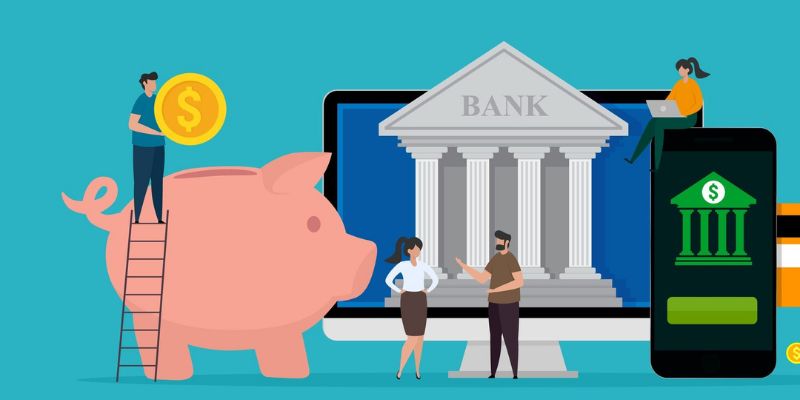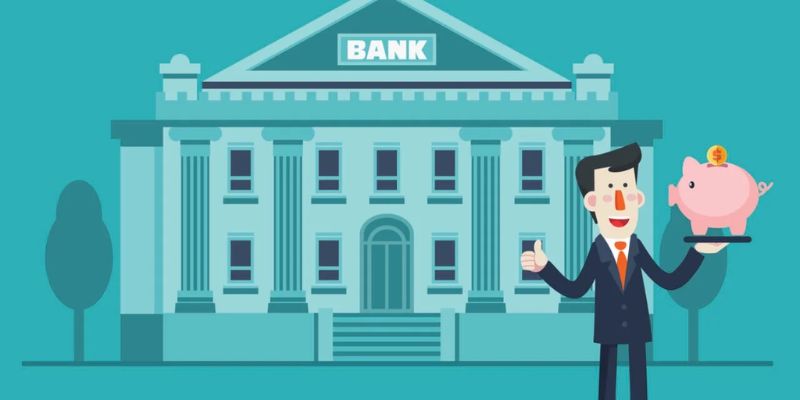Financial Disintermediation Unveiled: Are Banks Facing Obsolescence?
Let’s cut to the chase: Is financial disintermediation a threat to banks? You’ve heard the buzz about peer-to-peer lending and how it’s shaking up the bank scene. It’s all about skipping the middleman. That’s right, borrowers and savers now meet directly, and banks? They just watch from the sidelines. But it doesn’t stop there; fintech is pushing the envelope, making us all rethink what banking even means. This shift is flipping the finance game on its head, putting big pressure on the old bank giants. With blockchain banging on the door and nifty new apps stealing the show, banks are getting a run for their money—literally. So sit tight, because we’re about to dive into whether banks can withstand this tech tornado or if they’re on the brink of becoming yesterday’s news.
Understanding the Mechanisms of Financial Disintermediation
The Rise of Peer-to-Peer Lending and Its Impact on Traditional Banking
Imagine you want to borrow money. In the past, you’d go to your local bank. But today, websites match you with people willing to lend. This is peer-to-peer lending. It’s like online dating for your finances!
What is peer-to-peer lending?
It’s people giving loans to other people through a website, without a bank.
This change has left banks on edge. Before, they were the go-to for loans. Now, with just clicks, someone can get a loan online. No bank needed. This means banks lose customers. They make less money from loan fees and interest.
Peer-to-peer lending and banks are in a tug-of-war. Banks have trust and history. Peer-to-peer websites have convenience and often better rates. This mix shakes the banking world. It forces banks to rethink how they do business if they want to stay on top.
Fintech Innovations: Beyond the Banking Frontier
Fintech is changing money matters for us all. It’s technology making banking and paying as easy as sending a text.
What is fintech?
It’s any technology used to make financial services better. Like an app on your phone that helps you save money or make payments.
It’s everywhere. From apps that round up your change to save or invest, to using your phone to pay for groceries. Fintech firms are sprouting up with these ideas, pushing banks aside. They’re quicker, often cheaper, and many people feel they’re just better.
Banks are now sprinting to catch up. They’re making their own apps and trying new tech to keep customers happy. Banks know if they don’t adapt, they might lose out. This challenge keeps them awake at night, hoping not to become yesterday’s news.
With fintech, services became widespread that we never saw before. Got a phone? You can now carry a bank in your pocket. Want to send money overseas? It can be done in seconds for less. These were bank tasks. Now, other companies offer them too.
Banks and new financial companies have roles in our lives. But the more we use these new services, the more banks need to find new ways to stay important. It’s not just a challenge; it’s a whole new financial game.

The Strategic Challenges Posed by Decentralized Finance to Banks
Blockchain Technology: Redefining Financial Transactions
Let’s talk about how new tech shakes up old banks. You know the stuff that happens behind bank doors? Well, blockchain is changing all that. No more middle guys. We got digital ledgers keeping track, safe and sound. Fewer mistakes,
less cost, way faster. Banks used to handle this. Now, anyone with a computer might. So banks? They’re hustling to keep up. Imagine a vault that’s everywhere but nowhere. That’s blockchain for you, and it’s just the start.
The Rise of Non-Banking Financial Services and Their Market Share
Picture a world where your phone is your bank. Sounds wild, right? But it’s happening right now. Non-bank services are popping up, giving loans without ever setting foot in an actual bank. People and businesses lending money to each other, online, no bank in sight. Apps that let you invest in stocks with a few taps. Your cash, your control.
These new players are grabbing a bigger slice of the cash pie each day. They’re online, they’re mobile, and they’re what people want. Banks? They’re racing to catch up or team up with these new kids on the block. So, do banks have a future? Sure, but it’s a game changer. They need to adapt or get left behind.
Remember, folks, change isn’t coming; it’s already here. And it’s not just a phase – it’s the new way money moves.

Assessing the Economic Implications for Traditional Banks
The Shift in Bank Revenue Streams Due to Disintermediation
Banks make money in many ways. One key way is through lending. They take deposits, then lend out this money. They earn interest on loans. They charge fees for services. But a shift is happening. Now, non-bank companies offer loans. They use technology to connect people who have money with those who need it. This is called peer-to-peer lending. It cuts out banks as the middleman.
This change affects banks’ ability to earn. They might see a drop in income from loans. This is because more people and businesses turn to these new options. They offer lower rates or easier access. Even simple things like sending money has moved away from banks. Companies offer digital wallets. This means banks are no longer the only choice.
The Role of Digital Wallets and Online Payment Systems in Banking Competition
Paying for things is easier now. We use smartphones and computers. Before, banks were the main way to pay. Now, we have digital wallets and online systems. They are fast and handy. People use them to shop online or split a bill.
Banks now face stiff competition. Companies like PayPal or Venmo are big players. They work on the go, anytime, anywhere. This attracts customers. Especially the young ones who are always online.
Banks are trying to keep up. They also offer online services. But it’s tough. The new companies focus just on payments and do it well. They give banks a run for their money. Literally.
Banks have to think hard about the future. They need new ways to earn and keep customers. They could lose their spot if they don’t adapt. It’s a big challenge. But banks have been around for ages. They’ve faced change before. It’s all about evolving and finding new paths to success.

The Future Landscape of Banking: Adaptation or Obsolescence?
The Surge of Neobanks and Tech Firms in Financial Services
Banks are in a tight race today. Many ask, “Will banks still matter?” The truth is, they face a big test. Neobanks and tech firms are lining up to play the banking game. They offer folks easy ways to manage cash, without the bank visit hassle. Money matters are at your fingertips, thanks to these new players.
So, what’s a neobank, you might wonder? It’s like a bank, but all online. No branch to walk into. You just need your phone to start banking. This shift has big banks on their toes. They must think fast and act smart. Peer-to-peer lending adds to the mix, offering loans without a bank in the middle.
With apps, anyone can lend or borrow money. This cuts out the bank’s role. It makes you think, can banks keep up?
Regulatory and Market Responses to Financial Disintermediation
Let’s talk about rules and reactions to these big changes. Both are key to what happens next. Banks have rules they must follow, and these rules are changing. We see new rules come up to guide online money moves. It’s all about keeping your money safe.
Now, we’re seeing a tug of war in the market. On one side, banks are fighting to stay on top. On the other, new tech is pulling people away. The question is, “Can banks change quick enough?” If they don’t, they might fall behind. But there’s hope.
Banks are getting smart, too. They’re trying new tech to get better. Some even join hands with fintech firms, to offer you what new players do. This way, they hope to keep you with them.
How about folks like us? We just want our money safe and easy to handle. The good news is, all this change means we get more choices. Whether it’s a bank or an app, it’s all about what works for us.
Now, let’s not forget about loans. Banks were the go-to for many years. Not anymore. Today, you can get a loan right from your phone. This swift change shows how much power is shifting.
Banks must stay alert. They need fresh ideas to keep their place. The same goes for rules. They must be fair. They must work well for both banks and new tech. Only then will we all win.
In this wild race, who will take the lead? Only time will tell. But one thing’s sure: money talks, and it’s speaking a new language. Banks have to listen or risk being left behind.
As we look ahead, banks face a choice. Adapt and grow, or face the risk of fading away. We all watch and wait to see how the story unfolds. One thing’s clear: In this race, the ones who adapt will lead the way.
We’ve covered some big changes in finance. Peer-to-peer lending and fintech are shaking up old ways. They’re changing how we borrow, lend, and manage money. Banks are now facing big tests. Can they keep up with blockchain and new financial players? Many banks are struggling to make money like before. Digital wallets and online payments are tough competition.
What’s ahead for banks? It’s a mix. Some will adapt, embrace tech, and thrive. Others might not make it. Rules and markets are reacting to these shifts. As an expert, I see a finance world that’s fast-moving. Banks need to act now. They must change or risk being left behind. Let’s watch and see which banks will lead us into this bold new future.
Q&A :
How does financial disintermediation impact traditional banking?
Financial disintermediation can have a significant impact on traditional banks by reducing their role as intermediaries between savers and borrowers. As individuals and businesses bypass banks to invest or borrow directly from the market, banks may see a decrease in their deposit and lending activities, affecting their profitability and business model.
What are the risks associated with financial disintermediation for banks?
The risks for banks associated with financial disintermediation include loss of market share, reduced interest margins, and diminished customer base. As banks face competition from other financial services such as peer-to-peer lending platforms and crowdfunding, they may also encounter challenges in maintaining client relationships and fee-based revenue.
Can financial disintermediation be beneficial for consumers and businesses?
Yes, financial disintermediation can be beneficial for both consumers and businesses as it often leads to lower transaction costs, higher returns on investments, and more borrowing options. By accessing financial markets directly, consumers and businesses may also enjoy greater control over their financial choices and more tailored financial products.
What measures can banks take to respond to the threat of financial disintermediation?
Banks can adopt various measures to respond to financial disintermediation, including modernizing their technology infrastructure, developing new and innovative financial products, and enhancing their customer service experience. Embracing digital transformation and forming strategic partnerships with fintech companies can also help banks stay competitive.
How might financial disintermediation evolve in the future?
The trajectory of financial disintermediation is likely to evolve with advancements in technology, regulatory changes, and shifts in consumer behavior. As digital platforms continue to grow, and blockchain and cryptocurrencies gain more acceptance, banks may have to continue adapting to a changing financial landscape where disintermediation plays an increasingly prominent role.

